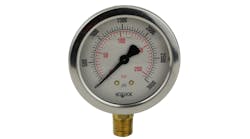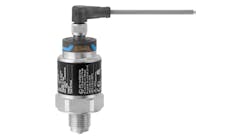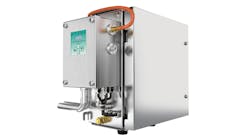AUSTIN, Texas, April 27, 2009 -- Emerson’s Smart Wireless technology is being used to help monitor an expansive natural gas pipeline transmission system as part of an upgrade to Bord Gáis’ above-ground installations in Ireland. New Rosemount wireless devices have replaced aging hard-wired devices as part of a trial to decide the future specification of such sites going forward and for other sites that are due upgrades.
Bord Gáis is a leading Irish energy provider, wholly owned by the government of Ireland, that is responsible for the supply, transmission and distribution of natural gas to over 600,000 customers. Management of the gas pipeline system is a sophisticated 24-hour operation involving constant monitoring through supervisory control and data acquisition (SCADA) systems. Gas is transmitted at high pressure, around 60 bar to 80 bar, from its main facilities and then at remotely located above-ground installations (AGIs), it is reduced appropriately to supply regional distribution points and commercial customers. Bord Gáis has in excess of 200 AGIs throughout Ireland, and at all these sites the gas lines in and out are monitored.
Existing AGIs have between three and twelve pressure transmitters measuring both inlet and outlet pressure. The cooling effect as a result of pressure reduction is also measured using temperature transmitters. These devices are connected, by hardwiring, to an onsite remote terminal unit (RTU) that transmits data back to a SCADA system master terminal unit at the central monitoring station in Cork. Should thresholds be exceeded to pressure or temperature, alarms are activated.
Bord Gáis’ Mains Renewal Programme aims to ensure that the Irish natural gas facility is one of the most modern pipeline systems in Europe. As part of the process, existing AGIs reaching the end of their lifespan are being upgraded with the latest instrumentation. One such site was at Middleton, near Cork, where a number of instruments needed to be upgraded with the latest temperature and pressure transmitters.
When Bord Gáis looked to upgrade the facility with new instrumentation, it was decided to use a network of wireless pressure and temperature transmitters. The Middleton site is quite unusual, as it is divided by a road. Although cable ducting was already in place and this could have been reused, this facility presented an excellent application to test wireless technology with a view to installing wireless at other AGIs.
“Having adopted GPRS (general packet radio service) as a `back up’ communications technology for our RTUs, we were very comfortable with wireless,” said Frank Smiddy, communication and instrumentation engineer, Bord Gáis. “We like to think that we are very forward thinking and open to new ideas, and we are always looking to improve our service using the latest technology.”
Whenever new AGIs are installed to support extensions to the pipeline system, or existing sites are upgraded, Bord Gáis is continually looking to minimize any installation costs. Power and data cabling are usually installed in ducting at the AGIs. However, burying cables can prove to be costly and time consuming. For the upgrade at Middleton, wireless promised to be lower cost, offered faster installation and start-up and easy integration into the existing RTUs using Modbus serial communications.
Although there is minimal traffic on the road dividing the Middleton facility, Bord Gáis could not use a line-of- sight wireless solution, as the signal may be interrupted by passing cars, affecting the reliability of communications. With Emerson’s self-organizing Smart Wireless technology, each measurement point has a redundant communication to the RTU via two or three routes. Wireless devices can act as a router for other nearby devices, passing messages along until they reach their destination. If there is an obstruction, transmissions are simply re-routed along the network until a clear path to the Smart Wireless Gateway is found. As conditions change or new obstacles are encountered in a plant, such as temporary scaffolding, new equipment, or a parked construction trailer, these wireless networks simply reorganize and find a way to get their signals through.
All of this happens automatically, without any involvement by the user, providing redundant communication paths and better reliability than direct, line-of-sight communications between individual devices and a receiver. This self-organizing technology optimizes data reliability while minimizing power consumption. It also reduces the effort and infrastructure necessary to set up a successful wireless network.
Because cabling enters into potentially explosive zones, regular checks of cable integrity as well as the condition of the EX barriers are required. This is especially important for older sites where there can be an aging cabling infrastructure. Wireless removes such concerns and reduces the number of site inspections needed.
At Middleton, Rosemount wireless transmitters include five measuring pressure, one differential pressure and one temperature; all transmitters have been successfully installed and are sending measurements back to the control room via the RTU. The devices are placed in enclosures, standard practice for all instrumentation used at Bord Gáis AGIs, and the Smart Wireless Gateway is positioned within the instrumentation kiosk, which is effectively a “walk in” enclosure.
“We found that the enclosures do not interfere with the signals at all. We tested a few devices that were positioned furthest away from the gateway, and these worked without any problems so we proceeded to install the rest of the transmitters,” explained Brid Sheehan, communication and instrumentation engineer, Bord Gáis. “Reliability of the wireless signal has not been an issue. We trend the wireless transmissions from the control room so we can see if there are any problems, but so far there haven’t been any.”



